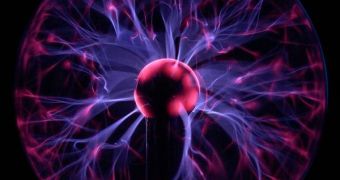When thinking of plasma, the first thing that comes to mind is temperature. A whole lot of it, in fact. Millions of degrees are required to turn gas into this state, and experts at the University of Southern California now want to use it on our teeth. They recently created a new plasma tool, which uses the matter to destroy bacterial biofilms on teeth, the main cause of them turning yellow. The microorganisms also contribute to bad breath.
The prototype for dentists' future tool resembles a tiny purple blowtorch, with a pencil-sized jet of plasma coming out of it. However, no reactor is required to make this contraption work, as the stuff always remains at room temperature. Still, it has the ability to annihilate bacteria with outstanding efficiency. In a study appearing in the June 2009 issue of Plasma Processes and Polymers, USC experts show that bacteria tend to come together in a slimy matrix, which boosts their ability to resist attackers. However, the new instrument renders any kind of matrix completely useless to the microorganisms, and destroys them shortly.
According to the Director of the USC Center for Biofilms, USC Assistant Professor of Clinical Dentistry Parish Sedghizadeh, bacterial colonies grown in the root canal of an extracted human tooth fell prey to the plasma tool so fast, that when the team analyzed the surface of the canal using scanning electron microscopes, they found a near pristine surface. He has been a co-author of the new study, “Nanosecond Pulsed Plasma Dental Probe,” alongside Ming Hsieh Department of Electrical Engineering-Electrophysics Research Assistant Professor Chunqi Jiang.
The two say that the active ingredient in the mix is atomic oxygen, as opposed to its molecular, diatomic version (O2). The conclusion was drawn after the team analyzed the plasma emission spectroscopy recorded during the treatment. Heat sensors placed on the tooth also revealed that its temperature only rose by about five degrees during a ten-minute test fire with the plasma tool, which means that it remains well within tolerable pain limits for humans.

 14 DAY TRIAL //
14 DAY TRIAL //